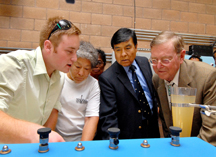
Sen. Pete Domenici, R-N.M., Jemez Pueblo Gov. James Roger Madalena, and Sandia VP for Energy Security and Defense Technologies Les Shephard were among those present to dedicate a new Jemez Pueblo Municipal Water Filtration System July 5.
Sandia demonstrated the coagulation filtration method of removing arsenic from drinking water as part of the dedication ceremony at Jemez Pueblo’s new water treatment facility. Sandia engineer Bill Holub (6118) explained that coagulation filtration was chosen from about 20 other types of filtration systems based on the chemical makeup of Jemez’ water.
This is the fourth arsenic-removal demonstration site in New Mexico that Sandia has established as part of a consortium made up of Sandia, the AWWA Research Foundation (AwwaRF), and WERC, a consortium for environmental education and technology development. The other arsenic-removal demonstration plants are located in Socorro, Anthony (Desert Sands), and Rio Rancho. A fifth is planned for a site in Oklahoma.
Project manager Richard Kottenstette (6118) says each of the four demonstration sites uses different arsenic-removal technologies. The coagulation-assisted filtration method being tested at Jemez Pueblo removes suspended and dissolved solids from the water. The method is currently being used in projects in El Paso and Paradise Hills (near Albuquerque). The pilot testing at Jemez Pueblo presents an opportunity to assess a small-scale test in a unique water quality environment, he says.
Domenici secured funding for the arsenic-removal test project through DOE as chairman of the Senate Energy and Water Development Appropriations Subcommittee.
This January, the arsenic standard for drinking water in the US was lowered from 50 to 10 parts per billion. These changes were intended to safeguard consumers from exposure to large quantities of arsenic.
During the dedication, Domenici said that many rural communities in New Mexico have arsenic levels that will now fail to meet the new water quality standards for arsenic.
Many smaller communities affected by the new standard have only a single source for fresh water and may be forced to install and maintain costly water treatment facilities. Part of the research underway includes evaluating costs associated with installation and maintenance of the various technologies.
The senator expressed concern that the new arsenic level restrictions could represent “a serious hardship” to smaller communities in many areas across the American Southwest, including Texas, Idaho, New Mexico, and large parts of Utah.
Jemez Pueblo’s water previously had slightly higher arsenic levels than allowed under a recently changed clean water law. Arsenic, manganese, and iron in Pueblo water has resulted in poor-tasting, rust-colored water that stained clothing and tasted unpleasant. These troubles bothered those in the community for years, Madalena said.
Worldwide, in areas that have been contaminated with arsenic through pollution and where naturally occurring levels of arsenic are high, arsenic contamination affects the water supply of millions of people.
Those sponsoring the project hope that the technologies being evaluated at the project’s many sites can someday be refined and adapted for use in low-cost applications in areas all over the world.